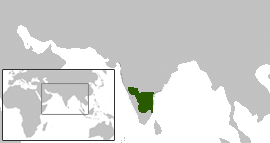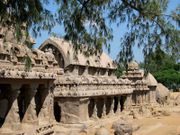Pallava
 Pallavas c.645 CE during Narasimhavarman I |
||
| Official languages | Tamil |
|
| Capital | Kanchipuram | |
| Government | Monarchy | |
| Clan | ||
| Preceding state | Satavahana, Kalabhras | |
| Succeeding states | Cholas, Eastern Chalukyas | |
The Pallava dynasty was a Tamil dynasty of South India which ruled the northern Tamil Nadu region and whole of Andhra Pradesh with their capital at Kanchipuram. The word Pallava in Sanskrit means branch. The Pallava dynasty is an offshoot of the Chola rulers . They expanded into the Guntur region of Andhra Pradesh. This area is still referred to as Palnadu or Pallava Nadu. Pallavas gained prominence after the eclipse of Satavahanas of Andhra and decline of Cholas in Tamil Nadu. The Pallavas patronized Tamil, Telugu and [Sanskrit]. Some of the most illustrious Sanskrit poets like Bharavi and Dandin and the seashore rock-cut temples of Mahabalipuram belongs to the Pallavan era.
Pallavas rose in power during the reign of Mahendravarman I (571 – 630 CE) and Narasimhavarman I (630 – 668 CE) and dominated the Telugu and northern parts of the Tamil region for about six hundred years until the end of the 9th century.
Throughout their reign they were in constant conflict with both Chalukyas of Badami in the north and the Tamil kingdoms of Chola and Pandyas in the south and were finally defeated by the Chola kings in the 8th century CE.
Pallavas are most noted for their patronage of architecture, still seen today in Mahabalipuram. The Pallavas, who left behind magnificent sculptures and temples, established the foundations of medieval south Indian architecture. Chinese traveller Hiuen Tsang visited Kanchipuram during Pallava rule and extolled their benign rule.
Many sources describe Bodhidharma, the founder of Chan Buddhism which later became known as Zen school of Buddhism in Japan, as a prince of the Pallava dynasty, a contemporary of Skandavarman IV and Nandivarman I,[1] and the son of Simhavarman II, though this is debatable.[2]
Contents |
Etymology
The word Pallava means branch in Sanskrit, in contrast with Chola meaning new country, Pandiya meaning old country and Chera meaning hill country in Sangam Tamil lexicon. The Pallavas are considered to be later offshoot of Cholas, who made Kanchipuram their capital and ruled Northern Tamil Nadu and Andhra Pradesh (till Northern Circars). They have also conquered Southern Karnataka.
Some historians believe that the word Pallava is rather of Persian origin and is from Pahlava or Pahlavi. Pahlavi script is extensively used in the Bactria, Persian region. Pallavas are of Indo-European sect who later migrated to Southern part of India, Malaysia,Indonesia via Andhra Pradesh
Origins
The origins of the Pallavas are shrouded in myths and legends. The Pallavas are described to belong to the line of sage Bharadwaja. Aswattama the son of Drona once while being in a hermitage near the province of Funan in South-East Asia was visited upon by the celestial nymph called Menaka who sought his hand. The child that they begot was called Pallava. Several grants recollect this by seeing Pallava's valour to be equal to that of "Aswattaman who that night of war relentlessly fought the demonic army of Ghatotgacha the son of Bheema." This apart several Pallavas were praised to have mastered and practiced alongside arms, the agamic worship rituals (sarva agama sastra paradrushtva). This apart the Pallava insignia of mace Khatvanga of Lord Siva and conch Samudraghosham of lord Siva was also sported by Aswattama. It is also true that several Pallava princes who took charges in Kanchi came from many distant islands also where extended the authority of the great kings, let alone from Indian subcontinent.
Pallava Chronology
The rule of the Pallavas apparently starts as early as 275 CE, but their greatest epoch corresponds to the 7th and 8th century.[3]
Early Pallavas
The history of the early Pallavas has not yet been satisfactorily settled. The earliest documentation on the Pallavas is the three copper-plate grants,[4] belonging to Skandavarman I and written in Prakrit.[5] Skandavarman appears to have been the first great ruler of the early Pallavas, though there are references to other early Pallavas who were probably predecessors of Skandavarman.[6]
Skandavarman extended his dominions from the Krishna in the north to the Pennar in the south and to the Bellary district in the West. He performed the Aswamedha and other Vedic sacrifices and bore the title of 'Supreme King of Kings devoted to dharma'.[5]
In the reign of Simhavarman IV, who ascended the throne in 436 BC, the fallen prestige of the Pallavas was restored. He recovered the territories lost to the Vishnukundins in the north up to the mouth of the Krishna. The early Pallava history from this period onwards is furnished by a dozen or so copper-plate grants in Sanskrit. They are all dated in the regnal years of the kings.[7]
With the accession of Nandivarman I (480-500 BC), the decline of the early Pallava family was seen. The Kadambas had their aggressions and attacked even the headquarters of the Pallavas with the Pallavas taking retaliatory measures by expelling and invading Kadamba territories in Karnataka. In coastal Andhra the Vishnukundins established their ascendency. The Pallava authority was confined to Tondaimandalam.
With the accession of Simhavishnu, father of Mahendravarman I, c. 575 BC, the Pallava revival began in the south.
Later Pallavas


The incursion of the Kalabhras and the confusion in the Tamil country was broken by the Pandya Kadungon and the Pallava Simhavishnu.[8][9] The Pallava kingdom began to gain both in territory and influence over the South Indian peninsula and were a regional power by the end of the 6th century.[10] The Pallavas exercised control over their southern neighbours of Cholas and Pandyas. But their history is marked by the continuous conflict with the Badami Chalukyas.[10]
Narasimhavarma I and Paramesvaravarma I were the kings who stand out with glorious achievements in both military and architectural spheres. Nandivarma II built the Shore Temple.
Kadava kingdom
During the thirteenth and the fourteenth centuries CE, a small principality of the Kadava dynasty came into brief prominence. These rulers claimed descent from the Pallavas. The notable rulers of this dynasty are Kopperunchinga I (reigned c.1216 - 1242 CE), and his son and successor Kopperunchinga II (c.1243 - 1279 CE). Together they extended the influence of their kingdom and played a major part in the ultimate demise of the Chola dynasty.
Religion
Pallavas were followers of Hinduism and made gifts of land to gods and brahmins. In line with the prevalent customs, some of the rulers performed the Aswamedha and other Vedic sacrifices.[7]
They were, however, tolerant of other faiths. The Chinese monk Xuanzang who visited Kanchipuram during the reign of Narasimhavarman I reported that there were 100 Buddhist monasteries, and 80 temples in Kanchipuram.[11]
Mahendravarman I was initially a patron of the Jain faith. He later re-converted to Hinduism under the influence of the Saiva saint Appar with the revival of Hinduism during the Bhakti movement in South India.[12]
Pallava architecture

The Pallavas were instrumental in the transition from rock-cut architecture to stone temples. The earliest examples of Pallava constructions are rock-cut temples dating from 610–690 CE and structural temples between 690–900 CE. A number of rock-cut cave temples bear the inscription of the Pallava king, Mahendravarman I and his successors.[13]
The greatest accomplishments of the Pallava architecture are the rock-cut temples at Mahabalipuram. There are excavated pillared halls and monolithic shrines known as rathas in Mahabalipuram. Early temples were mostly dedicated to Shiva. The Kailasanatha temple in Kanchipuram and the Shore Temple built by Narasimhavarman II are fine examples of the Pallava style temples.[14]
See also
| Middle kingdoms of India | ||||||||||||
| Timeline: | Northwestern India | Northern India | Southern India | |||||||||
|---|---|---|---|---|---|---|---|---|---|---|---|---|
|
6th century BCE |
(Persian rule)
(Islamic conquests)
(Islamic Empire) |
|
|
|||||||||
Notes
- ↑ Kamil V. Zvelebil (1987). "The Sound of the One Hand", Journal of the American Oriental Society, Vol. 107, No. 1, p. 125-126.
- ↑ Graeme Lyall. Seon - The Buddhism of Korea.
- ↑ Avari, p186
- ↑ Now referred to as the Mayidavolu, Hirahadagalli and the British Museum plates - Durga Prasad (1988)
- ↑ 5.0 5.1 Nilakanta Sastri, A History of South India, p91
- ↑ Nilakanta Sastri, A History of South India, pp91–92
- ↑ 7.0 7.1 Nilakanta Sastri, A History of South India, p92
- ↑ Kulke and Rothermund, p105
- ↑ Kulke and Rothermund, p120
- ↑ 10.0 10.1 Kulke and Rothermund, p111
- ↑ Kulke and Rothermund, pp121–122
- ↑ Appar
- ↑ Nilakanta Sastri, pp412–413
- ↑ Nilakanta Sastri, p139
References
- Avari, Burjor (2007). India: The Ancient Past. New York: Routledge.
- Dubreuil, G. Jouveau; Dikshitar, V. S. Swaminadha (1995). The Pallavas. India: Asian Educational Services. ISBN 8120605748.
- Hermann, Kulke; Rothermund D (2001) [2000]. A History of India. Routledge. ISBN 0-415-32920-5.
- Minakshi, Cadambi (1938). Administration and Social Life Under the Pallavas. Madras: University of Madras.
- Nilakanta Sastri, K.A (2002) [1955]. A History of South India. New Delhi: OUP.
- Prasad, Durga (1988). History of the Andhras up to 1565 A.D.. Guntur, India: P.G. Publishers.
- "South Indian Inscriptions". Archaeological Survey of India. What Is India Publishers (P) Ltd. http://www.whatisindia.com/inscriptions/. Retrieved 2008-05-30.